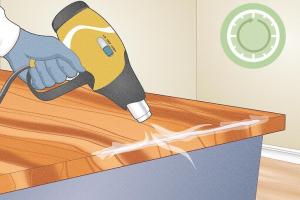Ultimate Guide: How to Effectively Remove Epoxy from Any Surface

-
Quick Links:
- 1. Introduction
- 2. Understanding Epoxy
- 3. Why Remove Epoxy?
- 4. Tools and Materials Needed
- 5. Methods of Epoxy Removal
- 6. Step-by-Step Guide to Removing Epoxy
- 7. Safety Tips
- 8. Case Studies and Real-World Examples
- 9. Expert Insights
- 10. FAQs
- 11. Conclusion
1. Introduction
Epoxy is a versatile and durable adhesive widely used in construction, arts and crafts, and even automotive repairs. However, there are times when you may need to remove epoxy due to mistakes, wear and tear, or changes in project direction. This guide will provide you with comprehensive information on how to effectively remove epoxy from various surfaces.
2. Understanding Epoxy
Epoxy is a thermosetting polymer that cures when mixed with a hardener. It is known for its strong adhesion, chemical resistance, and durability. Understanding its properties is essential for proper removal techniques.
Types of Epoxy
- Epoxy Resins
- Epoxy Adhesives
- Epoxy Coatings
3. Why Remove Epoxy?
There are several reasons to remove epoxy:
- Correcting application mistakes
- Surface preparation for new finishes
- Repairing or replacing damaged parts
4. Tools and Materials Needed
Before starting the epoxy removal process, gather the following tools and materials:
- Heat Gun or Hair Dryer
- Scraper or Putty Knife
- Solvent (Acetone, Isopropyl Alcohol)
- Protective Gear (Gloves, Goggles, Mask)
- Sandpaper or Power Sander
- Plastic Sheets or Drop Cloths
5. Methods of Epoxy Removal
There are several effective methods for removing epoxy, including:
5.1 Heat Method
Using heat can soften epoxy, making it easier to scrape off.
5.2 Solvent Method
Certain solvents can dissolve epoxy, allowing for effective removal.
5.3 Mechanical Method
For more stubborn epoxy, mechanical methods using sanders or grinders may be necessary.
6. Step-by-Step Guide to Removing Epoxy
6.1 Heat Method Steps
- Set up a work area with proper ventilation.
- Use a heat gun or hair dryer to warm the epoxy.
- Once softened, carefully scrape off the epoxy using a putty knife.
- Clean the area with a cloth and solvent to remove residue.
6.2 Solvent Method Steps
- Apply the solvent to the epoxy using a cloth or brush.
- Allow the solvent to sit for the recommended time.
- Scrape off the epoxy carefully.
- Rinse the area with water or a suitable cleaner.
6.3 Mechanical Method Steps
- Wear protective gear before starting.
- Use sandpaper or a power sander to remove the epoxy.
- Be cautious to avoid damaging the underlying surface.
- Finish with a clean-up using a vacuum or damp cloth.
7. Safety Tips
When working with epoxy and removal methods, safety is paramount. Here are some essential safety tips:
- Always wear gloves and goggles to protect your skin and eyes.
- Work in a well-ventilated area to avoid inhaling fumes.
- Follow all manufacturer instructions on solvents and tools.
8. Case Studies and Real-World Examples
Let's explore a few case studies where epoxy removal was successfully executed:
Case Study 1: Kitchen Countertops
A homeowner needed to remove epoxy from their kitchen countertops to replace them with a new material. Using a combination of heat and solvents, they successfully removed the epoxy without damaging the countertops.
Case Study 2: Garage Floor
In a garage renovation, an epoxy floor was removed using a mechanical method. The use of a power sander allowed for quick and effective removal, followed by a clean-up process that prepared the floor for new epoxy.
9. Expert Insights
We spoke to several experts in the field about their best practices for epoxy removal. Here are some highlights:
"Patience is key when removing epoxy. Rushing can lead to surface damage." - Jane Doe, Home Renovation Expert
"Always test any solvent on a small area first to ensure it won’t damage the underlying surface." - John Smith, DIY Specialist
10. FAQs
1. Can I remove epoxy from wood surfaces?
Yes, you can remove epoxy from wood using heat or solvents, but be careful not to damage the wood.
2. Is it safe to use a heat gun indoors?
It is generally not safe to use heat guns indoors due to the risk of fire and fumes. Always use them in a well-ventilated area.
3. How long does epoxy take to cure?
Epoxy usually takes about 24 hours to cure, but this can vary based on the product and environmental conditions.
4. What solvents work best for removing epoxy?
Acetone and isopropyl alcohol are commonly effective solvents for removing epoxy.
5. Can I use vinegar to remove epoxy?
Vinegar may help soften epoxy but is not as effective as dedicated solvents.
6. Will sanding damage the surface underneath the epoxy?
Yes, sanding can damage underlying surfaces, so proceed with caution and use lower grits first.
7. How do I know if the epoxy is fully removed?
Ensure that no sticky residue remains and that the surface is clean and smooth to the touch.
8. Can I remove cured epoxy?
Yes, cured epoxy can be removed, but it may require more effort and the use of solvents or mechanical methods.
9. Is there a way to prevent epoxy from sticking?
Using a release agent or wax can help prevent epoxy from sticking to surfaces during application.
10. What should I do if I accidentally spill epoxy?
Act quickly by using solvents to clean up the spill before it cures, applying heat if necessary.
11. Conclusion
Removing epoxy can be a challenging task, but with the right tools, methods, and safety precautions, it can be done effectively. Whether you are a DIY enthusiast or a professional, this guide should serve as a comprehensive resource for all your epoxy removal needs.